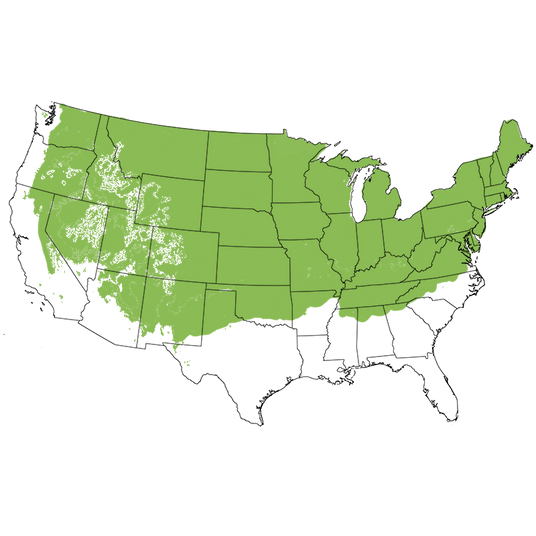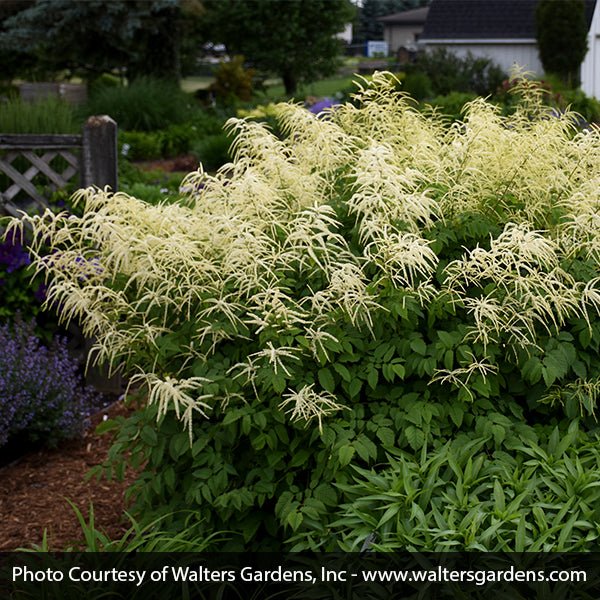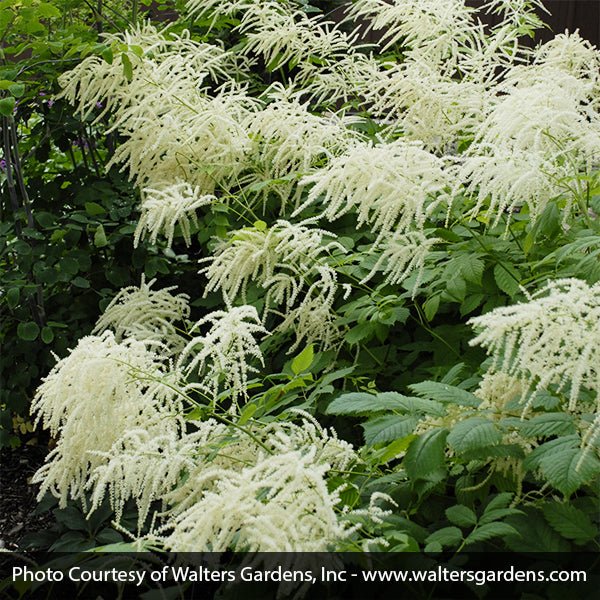Goat's Beard
Aruncus dioicus
Plant Sentry™
Plant Sentry™

Plant Sentry™ Protected
Your order is protected by our compliance system that:
- Prevents restricted plants from shipping to your state
- Ensures plants meet your state's agricultural requirements
- Protects gardens from invasive pests and diseases
Delivery and Shipping
Delivery and Shipping
Delivery and Shipping
Fast, Safe Plant Delivery
Ships in 3-4 business days • Tracking provided • Weather protected
| Under $50 | $9.99 |
| $50 - $99.99 | $14.99 |
| $100 - $149.99 | $16.99 |
| $150 - $198.99 | $24.99 |
| $199+ | FREE |
✓ Zone-specific timing • ✓ Professional packaging • ✓ Health guarantee
Understanding Plant Options
Nature Hills offers plants in two main formats:
- Container Plants: Grown in pots with soil, sized by container volume and plant age
- Bare Root Plants: Dormant plants without soil, sized by height measurements
Container Plant Sizes
Container sizes indicate plant age and growing capacity rather than liquid volume equivalents. Our containers follow industry-standard nursery "trade gallon" specifications, which differ from standard liquid gallon measurements.
Young Plants (6 months to 18 months old)
| Container Size | Actual Volume | Metric Equivalent |
|---|---|---|
| 2" x 2" x 3" | 0.18 - 0.21 dry quarts | 0.20 - 0.23 dry liters |
| 4" Container | 0.31 - 0.87 dry quarts | 0.35 - 0.96 dry liters |
| 4.5" Container | 0.65 dry quarts | 0.72 dry liters |
| 6" Container | 1.4 dry quarts | 1.59 dry liters |
| 1 Quart | 1 dry quart | 1.1 dry liters |
| 5.5" Container | 1.89 dry quarts | 2.08 dry liters |
Established Plants (18 months to 2.5 years old)
| Container Size | Actual Volume | Metric Equivalent |
|---|---|---|
| 2 Quart | 2 dry quarts | 2.2 dry liters |
| #1 Container | 2.26 - 3.73 dry quarts | 2.49 - 4.11 dry liters |
| 5" x 5" x 12" | 3.5 - 4.3 dry quarts | 3.85 - 4.74 dry liters |
Mature Plants (2-4 years old)
| Container Size | Actual Volume | Metric Equivalent |
|---|---|---|
| #2 Container | 1.19 - 1.76 dry gallons | 5.24 - 7.75 dry liters |
| #3 Container | 2.15 - 2.76 dry gallons | 8.14 - 12.16 dry liters |
Large Plants (3-5 years old)
| Container Size | Actual Volume | Metric Equivalent |
|---|---|---|
| #5 Container | 2.92 - 4.62 dry gallons | 12.86 - 20.35 dry liters |
| #6 Container | 5.25 - 6.01 dry gallons | 23.12 - 26.42 dry liters |
| #7 Container | 5.98 - 6.53 dry gallons | 26.34 - 28.76 dry liters |
Bare Root Plants
Bare root plants are sold by height from the root system to the top of the plant. Plants may exceed minimum height requirements.
Common Sizes:
- Trees: 1 foot, 2 feet, 3 feet, 4 feet, 5 feet, 6 feet
- Shrubs & Perennials: 1 foot, 18 inches, 2 feet
Important Notes
Container Volume Specifications
- Trade Gallon Standard: Our containers follow industry-standard "trade gallon" specifications established by the American National Standards Institute (ANSI Z60.1) for nursery stock
- Volume Variations: Actual soil volume may vary due to plant root systems and growing medium settlement
- Age Indicators: Container size primarily indicates plant age and maturity rather than liquid volume equivalents
Growing Conditions
- Plant size can vary based on variety and growing conditions
- Container size helps indicate plant maturity and establishment level
- Larger containers generally mean more established root systems and faster landscape establishment
Seasonal Availability
- Bare root plants are available seasonally when dormant
- Container plants are available throughout the growing season
- Specific varieties may have limited availability in certain sizes
Questions?
For questions about specific plant sizes or availability, please contact our plant experts who can help you choose the right size for your landscape needs.

Plant Sentry™ Protected
Your order is protected by our compliance system that:
- Prevents restricted plants from shipping to your state
- Ensures plants meet your state's agricultural requirements
- Protects gardens from invasive pests and diseases
Plant Profile & Growing Essentials
Cold hardy, Low Maintenance, Native, Flowering, Deer-resistant, Wet Soils, Clay Tolerant, Attracts pollinators, and Non-invasive
Specifications
Specifications
-
Botanical Name
-
Height
-
Width
-
Growing Zones
-
Sunlight
-
Growth RateModerate
-
Flower Color
-
Leaf Color
-
Fall Color
-
Pollinator FriendlyYes
-
Bloom PeriodEarly Summer, Late Summer
-
Does Not Ship ToAK, HI, ID, MT
Planting & Care
Planting & Care
Incredible Floral Fireworks Goat’s Beard
- Feathery White Blooms
- Flowers Early to Mid Summer
- Wildflowers Are Held High Above Foliage
- Native Perennial
- Superb Nectar Support for Beneficial Pollinators
- Long-Lasting Cut Flower
- Textured Green Leaves
- Showy, Large-Scale Accent
- Yellow Fall Color With Cool Weather
- Widely Adaptable
- Cold-Hardy and Heat Tolerant
- Full Sun or Partial Shade
- Seldom Damaged by Deer
Improve the look of your landscape with Goat’s Beard (Aruncus dioicus). These bold, blooming native perennials make a big impact with their creamy-white plumes and noteworthy, toothed foliage.
Goat's Beard flowers produce nectar which is very popular with butterflies and beneficial pollinators. This is a great plant to include in Butterfly Gardens and to plant near Victory Gardens, too.
You'll appreciate the feathery, tiered blooms for weeks! There is no way to miss these ornamental flowers...as they are held high above the bushy clump of foliage.
Plant plenty to have enough for cut flower arrangements indoors. Don't forget to utilize the dark green, pinnately compound leaves to "pop" the flowers in your vase.
You may know these majestic perennials as Bride's Feathers. Although it looks like a huge, white-blooming Astilbe, this native plant is actually a member of the Rosaceae family.
These lovely, large plants with their creamy-white flowers make an outstanding addition to woodland plantings in dappled shade. With consistent moisture, it tolerates a site in full sun as well.
Their pretty, corrugated foliage looks great all season. When the fall weather cooperates, you'll even enjoy a golden-yellow color.
Gain a naturalized look in your landscape with help from the airy plumes of Goat's Beard. Order today!
How to Use Goat's Beard in the Landscape
Make your yard look larger with a time-tested professional design tip. Use a single specimen at a pivotal turn in your garden border...where the "see-through" blooms can add a sophisticated sense of "peek-a-boo" mystery for garden visitors.
If you need soft—yet effective—screening, add several in a gorgeous flowering hedge. Plant them two feet apart on center, measuring from the center of one to the center of the next.
They also make an incredible backdrop for shorter perennials and mixed shrubs. There is nothing quite as eye-catching as a stand of Goat's Beard in full bloom.
If you grow fruiting plants or have an annual veggie garden, you'll be thrilled at how many beneficial pollinators are attracted to these unique native plants.
Aruncus looks great around the perimeter of a pond, near the water's edge. Gain a very lavish reflected display.
At the edge of a woodland border, partner them with true Astilbes, Ferns and Anemone. Their white blooms will enchant you on a stroll in early summer.
#ProPlantTips for Care
In the cooler Zones, give them a spot with rich soil in full sun and regular moisture. Otherwise, plant them in part shade with at least four hours of sunlight a day.
Be patient with your young Goat's Beard as it gets established. During planting, give them Nature Hills Root Booster to support their feeder roots with a life-long symbiotic relationship that enables better absorption of water and micronutrients.
Mulch is important to keep their root systems nice and cool. Pull it back from the stems, and provide a moderate amount of water on a consistent basis.
Leave the spent cream-colored plume of flowers on the plant to dry for winter interest. Trim them back, if you prefer a manicured look.
Cut dioecious Goat's Beard back to ground level in spring. Each spring, you'll see all fresh new foliage emerge from the crown. Both male and female plants bloom yearly on that new growth.
Order these expertly-grown wildflowers today! Goat's Beard makes a very useful native landscape perennial. Enjoy yours!













